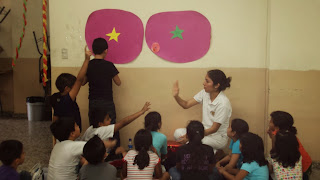Teachers: Luis and Gloria
Topic: Clothes
Vocabulary: Jeans, shorts, dress,
blouse, skirts, t-shirt, socks, shoes, glasses, hat, cup, sweater.
Grammar: I am wearing, she is
wearing, and he is wearing.
Whose _____is this? Whose
_______are these?
It was Luis and Gloria’s class, the second teaching
group in the third period. I think they improved a lot their teaching because I
could notice that they did many great activities that gave a nice environment
to the entire class. I really enjoyed it. Once again I will not focus on my
case of study because, unfortunately, she was not there…
Gloria started the class with the warm up activity
which was the “how are you” song, I liked the way of how she gave her own touch
to the activity because children had to not only sing the song but also raise
some faces at the time of mentioning every mood (hungry, happy, and sad). Even
though it was a great change, I consider children did not understand the
instructions at all because they did not sing as other times, but they were
more focused on raising the faces, and even some of them in some times raised
mistaken faces. I do not know, but I think that with clearer instructions,
children had done a better task.
Next, she presented the topic by showing some
flashcards about clothes items. It was interesting because at the same time of
encountering the target language, children were reviewing the topics: colors
and numbers. In addition, something that
I really like of Gloria’s attitude was that every time that children were
talking, she changed their position so they could be more attentive.
Practice
One interesting activity was about wearing body
shapes.
In this activity, boys had to wear to Ricardo (a boy’s body shape) and
girls to Fabiola (a girl’s body shape), so they had to follow Gloria’s modeling
in one of the shapes. This was a great task. However, I consider that it could
have been more successful if all children have had both body shapes and Gloria
had modeled one by one in order they got not confused and they could use all
item clothes they had in the bags. Even though it was a nice activity in which
students at
this stage are ready to perform it very well because at their age,
they already can differentiate among what is for boys and for girls. Most of
the children wore their body shape according to what every gender must wear.
Nevertheless, I could see that one of the boys had used all the clothes item
and he had paste a skirt in the boy’s body shape. I consider it was not because
the child does not have that knowledge, but probably because he could have
thought that they were going to use all the items because they were in the bag.
Thus, I consider that children could have had both body shapes, so they can
show that difference.

Another very interesting and nice activity that
children and most of us enjoyed was when Luis used the memory game activity. At
this age, children have developed their brain, so they can use their memory and
self-awareness for performing this kind of activity. Through this activity,
children were able not only to use their cognitive area but also to practice
the new target language and review the colors and numbers as every time that
students participated, they had to choose two colors and two numbers, so it
made them increase their knowledge. Also, something that made them get involved
in the task was that when the first child formed a pair and Luis gave it to her,
many of them wanted to participate because they also wanted to get pairs. For
me it was an amazing activity. However, I could realize that it would have been more
appealing if Luis had had an order by which all children could
participate. For this, he could have made maybe lines in order to every
children participated the same times.

Moreover, something that I REALLY liked and enjoyed as
the children was the “good bye” song because of the complete change and style
that Luis gave to it. It was not the simple song that we have sung in all
classes, but it was a complete “boom”, and as me, everyone was astonished of
that…
Without doubt, they overcame most of the problems that
we had had previously, and of course they increased a lot their way of
teaching because besides of those little problems, they definitely did a good
job!
Congratulations Luis and Gloria for this great
class!!!! Personally, I liked it so much!!! :D
References:
Papalia, D., et al. A child's world. pp. 239-290. Mc
Graw Hill. USA, 2006

.jpg)

.jpg)


























